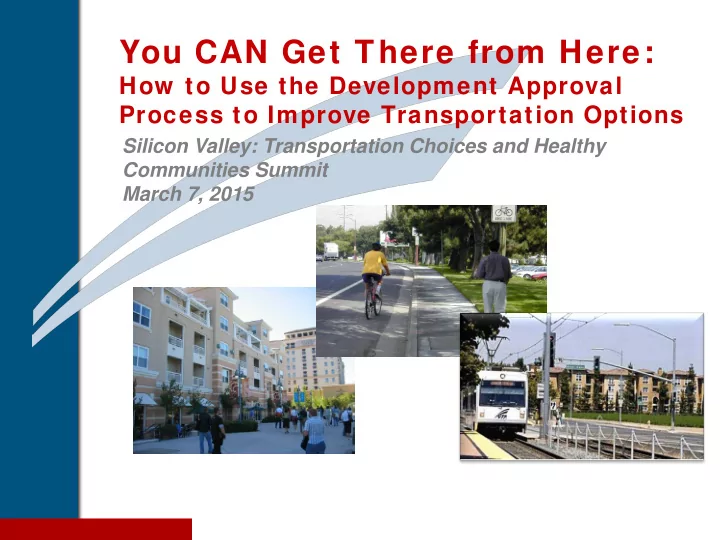

You CAN Get There from Here: How to Use the Development Approval Process to Improve Transportation Options Silicon Valley: Transportation Choices and Healthy Communities Summit March 7, 2015 Development Review Program 1
Outline • Transportation Impact Analysis (TIA) Basics – What they are, Who prepares them, and Why it’s important • 2014 TIA Update – Improved Bicycle, Pedestrian and Transit Analysis • How to leverage the TIA process for better Multimodal Improvements 2
What is a TIA? • A TIA (Transportation Impact Analysis) summarizes the transportation impacts of a development project or plan. • TIAs help inform decision-makers and the public during the development review process. • The information in a TIA is also usually used in an environmental study (e.g., Environmental Impact Report) VTA Congestion Management Program 3
Who prepares a TIA? How does it fit in the process? • TIAs are prepared by local agencies (cities, towns, counties), generally with the assistance of transportation consulting firms. • TIA Guidelines are generally established by the Congestion Management Agency for each county (e.g. VTA for Santa Clara County, C/CAG for San Mateo County, etc.) • TIAs are prepared to address local issues (e.g., a city’s policy for operation of its streets) and, for larger projects, to meet Congestion Management requirements. VTA Congestion Management Program 4
Why are TIAs important? • The analysis in a TIA affects whether a project is required to adopt mitigation measures, or how large a transportation fee it must pay (if a fee program exists). • Transportation analysis may also determine how much growth can be accommodated, in a General Plan or an area plan. VTA Congestion Management Program 5
2014 VTA TIA Guidelines Update • Emphasize the reduction of auto trips • Take a balanced, multimodal approach to addressing congestion In a nutshell: Provide better information to enable better decision-making VTA Congestion Management Program 6
100 Pages for Cars and Two for Everything Else? VTA Congestion Management Program 7
Development and Congestion: Conventional Approach Mitigation Measures - Road widening Evaluate - Connections to Transit Estimate - Shuttle programs Impacts on - Bike/Pedestrian improvements Auto Trips Impact Fees Roadways Significant & Unavoidable Impacts Congestion More Widen People Roadways Drive Faster Driving Source: Jeffrey Tumlin, Nelson/Nygaard VTA Congestion Management Program 8
Development and Congestion: Comprehensive Approach Sensible Estimate Auto Trips Mitigation Consider Auto Trip Evaluate Measures Reductions All Modes Reduced Fees - Transit/walk/bike friendly locations Fewer Significant - TDM (Shuttles, carpool, bike, transit incentives) Impacts - Parking pricing & management More Trip Reduction Efforts, Less Driving VTA Congestion Management Program 9
Improved Analysis of Pedestrian, Bicycle and Transit • Improve documentation of pedestrian & bicycle existing conditions • Shift pedestrian & bicycle analysis from emphasizing capacity to focusing on quality/safety/comfort • Provide guidance for analyzing the impacts of auto mitigation measures on other modes • For transit analysis, focus on impacts on transit travel times 10
Auto Trip Reduction Statement VTA Congestion Management Program 11
Key Things to Look for in a TIA • Sidewalk presence/width • Project efforts to reduce auto trips (e.g. transit pass, • Street trees and buffers trip monitoring, etc.) • Pedestrian crossings • Parking management • Pedestrian paths within site • Connections to existing • Bike lanes development nearby • Bike parking • Site design (orientation of • Project location buildings to sidewalk, etc.) If you don’t see an analysis or don’t think it’s sufficient, ask for it! VTA Congestion Management Program 12
How to Leverage the TIA Process Effective Strategies Less Effective Strategies • Review a TIA as soon as possible – often included as an Appendix to • Simply stating that you dislike the CEQA document (e.g. DEIR, Initial project Study) • Stating that the numbers in the TIA • Focus on the transportation analysis: are not correct, without providing evidence o Were pedestrian, bicycle and transit conditions described • Suggest improvements greatly out of accurately? scale with the project (e.g. asking a small residential project to revamp o Is the project doing enough to the city’s entire bike trail network) reduce auto trips and support alternative modes? o Suggest an improvement at the appropriate scale for the project. VTA Congestion Management Program 13
Questions and Discussion vta.org/cmp/tia-guidelines Rob Swierk, AICP – robert.swierk@vta.org Rob Cunningham – robert.cunningham@vta.org 14
Recommend
More recommend